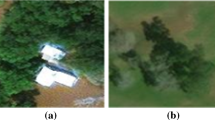Abstract
Hurricanes are among the most destructive natural phenomena on Earth. Timely prediction and tracking of hurricane intensity is important as it can help authorities in emergency planning. Several manual, semi and fully automated techniques based on different principles have been developed for hurricane intensity estimation. In this paper, a deep convolutional neural network architecture is proposed for fully automated hurricane intensity estimation from satellite infrared (IR) images. The proposed architecture is robust to errors in annotation of the storm center with a smaller root-mean-squared error (RMSE) (8.82 knots) in comparison to the previous state of the art methods. A web server implementation of Deep-PHURIE and its pre-trained neural network model are available at the URL: http://faculty.pieas.edu.pk/fayyaz/software.html#Deep-PHURIE.






Similar content being viewed by others
References
“Hurricanes and Tropical Storms - Annual,” NOAA National Center for Environmental Information, 2017. https://www.ncdc.noaa.gov/sotc/tropical-cyclones/201713/. Accessed 10 Mar 2018
Dvorak VF (1975) Tropical cyclone intensity analysis and forecasting from satellite imagery. Mon Weather Rev 103(5):420–430
Velden CS, Olander TL, Zehr RM (1998) Development of an objective scheme to estimate tropical cyclone intensity from digital geostationary satellite infrared imagery. Weather Forecast 13(1):172–186
Olander TL, Velden CS (2007) The advanced Dvorak technique: continued development of an objective scheme to estimate tropical cyclone intensity using geostationary infrared satellite imagery. Weather Forecast 22(2):287–298
Piñeros MF, Ritchie EA, Tyo JS (2011) Estimating tropical cyclone intensity from infrared image data. Weather Forecast 26(5):690–698
Ritchie EA, Valliere-Kelley G, Piñeros MF, Tyo JS (2012) Tropical cyclone intensity estimation in the North Atlantic Basin using an improved deviation angle variance technique. Weather Forecast 27(5):1264–1277
Fetanat G, Homaifar A, Knapp KR (2013) Objective tropical cyclone intensity estimation using analogs of spatial features in satellite data. Weather Forecast 28(6):1446–1459
Asif A, Dawood M, Jan B, Khurshid J, DeMaria M, Minhas FulAA (2018) PHURIE: hurricane intensity estimation from infrared satellite imagery using machine learning. Neural Comput Appl. https://doi.org/10.1007/s00521-018-3874-6
Pradhan R, Aygun RS, Maskey M, Ramachandran R, Cecil DJ (2018) Tropical cyclone intensity estimation using a deep convolutional neural network. IEEE Trans Image Process 27(2):692–702
Knapp KR (2017) Hurricane satellite (HURSAT) from international satellite cloud climatology project (ISCCP) B1, version 6 title. NOAA Natl. Cent. Environ. Inf
Knapp KR, Kruk MC, Levinson DH, Diamond HJ, Neumann CJ (2010) The International Best Track Archive for Climate Stewardship (IBTrACS). Bull Am Meteorol Soc 91(3):363–376
Hurricane Satellite HURSAT-B1 version 06 data. https://www.ncei.noaa.gov/data/hurricane-satellite-hursat-b1/archive/v06/. Accessed 27 Oct 2018
LeCun Y et al (1989) Backpropagation applied to handwritten zip code recognition. Neural Comput 1(4):541–551
Kingma DP, Ba J (2014) Adam: a method for stochastic optimization. http://arxiv.org/abs/1412.6980(2014)
Montufar GF, Pascanu R, Cho K, Bengio Y (2014) On the number of linear regions of deep neural networks. In: Ghahramani Z, Welling M, Cortes C, Lawrence ND, Weinberger KQ (eds) Advances in neural information processing systems, vol 27. Curran Associates Inc, Red Hook, pp 2924–2932
Srivastava N, Hinton G, Krizhevsky A, Sutskever I, Salakhutdinov R (2014) Dropout: a simple way to prevent neural networks from overfitting. J Mach Learn Res 15(1):1929–1958
Ioffe S, Szegedy C (2015) Batch normalization: accelerating deep network training by reducing internal covariate shift. In: The 32nd international conference on machine learning, pp 448–456
Kotikalapudi R, Contributors (2017) Keras visualization toolkit. GitHub. https://github.com/raghakot/keras-vis
Acknowledgements
The authors are grateful to Dr. Mark DeMaria and Dr. John Knaff, National Hurricane Center, NOAA, USA for their valuable contribution to the project. AA and MD are funded by the IT Endowment Fund at PIEAS. We will also like to recognize the support by Higher Education Commission (HEC) of the government of Pakistan for establishment of PIEAS Data Science Lab whose computational resources were utilized in this work.
Author information
Authors and Affiliations
Corresponding author
Ethics declarations
Conflict of interest
All authors declare that they have no conflict of interest.
Additional information
Publisher's Note
Springer Nature remains neutral with regard to jurisdictional claims in published maps and institutional affiliations.
Rights and permissions
About this article
Cite this article
Dawood, M., Asif, A. & Minhas, F.u.A.A. Deep-PHURIE: deep learning based hurricane intensity estimation from infrared satellite imagery. Neural Comput & Applic 32, 9009–9017 (2020). https://doi.org/10.1007/s00521-019-04410-7
Received:
Accepted:
Published:
Issue Date:
DOI: https://doi.org/10.1007/s00521-019-04410-7




